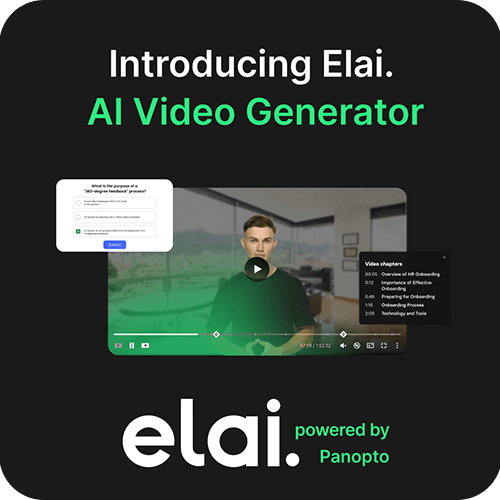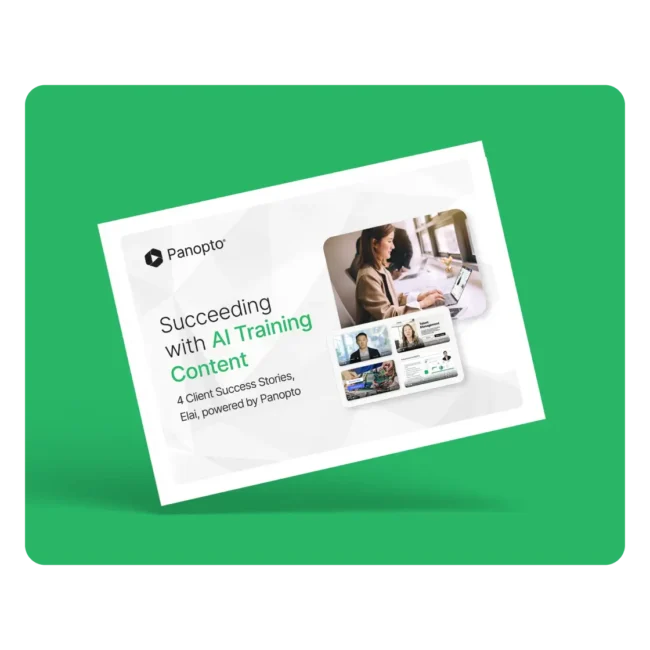- Higher Education
5 Ways to Leverage AI in Higher Education

AI in higher education is transforming the way institutions teach, learn, and manage resources. From creating personalized learning experiences to making knowledge more accessible, AI bridges gaps and drives efficiency. It’s helping universities streamline administrative tasks, enhance student engagement, and build inclusive environments that support diverse learning needs. As higher education evolves, AI provides the tools to meet rising expectations and innovate for the future.
Here are five ways to leverage AI in higher education:
- Create Smarter Knowledge Repositories with AI in Higher Education
- Enhance Student Engagement with AI-Driven Video Features
- Support Inclusive Learning Environments with AI
- Streamline Administrative Processes with AI-Integrated Tools
- Harness Generative AI for Smarter Content Creation
Creating Smarter Knowledge Repositories with AI in Higher Education
AI in higher education solves one of the most persistent challenges for institutions: managing and accessing vast amounts of learning material. Universities generate enormous quantities of content each semester—lectures, assignments, research, and administrative resources. However, organizing this information into a coherent, accessible system has traditionally been a daunting task.
Enter AI-powered video libraries. These tools transform disorganized archives into searchable, structured repositories that save time and improve learning outcomes. Imagine a student needing to review a specific lecture topic. Instead of scrolling through hours of video, they can type a keyword into a search bar and instantly find the exact moment in the recording they need.
AI doesn’t just make searching easier; it revolutionizes how institutions store and use their knowledge. Video content becomes indexed by spoken words, text on slides, and metadata, creating a dynamic resource for students and faculty alike. Faculty can organize course materials effortlessly, and students gain access to a wealth of easily navigable resources.
With AI in higher education, knowledge isn’t just stored—it’s unlocked. Institutions can deliver the right information to the right people at the right time, streamlining learning for everyone involved.
Enhancing Student Engagement with AI-Driven Video Features
Keeping students engaged is an ongoing challenge, especially in today’s digital and hybrid learning environments. AI in higher education offers a solution by transforming traditional passive learning into an active, personalized experience.
Imagine a student revisiting a recorded lecture before an exam. Instead of watching an hour-long video, they use AI-powered tools to search for specific topics, instantly jumping to the moments that matter most. This isn’t just convenient—it keeps students focused and reduces cognitive overload.
AI also boosts engagement by providing students with on-demand access to resources tailored to their needs. Students can pause, replay, or review specific sections at their own pace, creating a more interactive and self-directed learning journey. For faculty, AI analytics reveal how students interact with video content—pinpointing which topics resonate and where additional support may be needed.
The result? Smarter learning experiences that empower students to take control of their education. By using AI-driven video features, institutions create a more engaging, effective environment for students while gathering valuable insights to refine teaching strategies.
Supporting Inclusive Learning Environments with AI
Accessibility is a cornerstone of modern education, yet many institutions still struggle to provide resources that meet diverse learning needs. AI in higher education is changing that, creating inclusive environments where all students can thrive.
AI-powered transcription and captioning tools ensure that lecture content is accessible to students with hearing impairments or those who learn best through visual aids. For non-native speakers, translation capabilities break down language barriers, making complex academic content understandable and inclusive.
For example, students with hearing impairments no longer need to rely solely on notes or accommodations—they can follow along with real-time captions generated by AI. Similarly, international students can benefit from translated subtitles that allow them to engage with course material more effectively.
Beyond accessibility, AI-driven tools promote equity by offering personalized support to students who may struggle with traditional teaching methods. By tailoring content delivery, AI ensures every learner gets the resources they need to succeed.
This isn’t just about compliance—it’s about creating a culture of inclusion that benefits everyone. When institutions embrace AI, they open the doors to education for students who may otherwise face barriers to success.
Streamlining Administrative Processes with AI-Integrated Tools
Administrative tasks often take valuable time away from teaching and research. AI in higher education addresses this by automating routine processes, allowing faculty and staff to focus on what truly matters—educating students.
One of AI’s most impactful applications is its seamless integration with existing tools like Learning Management Systems (LMS), Zoom, and Microsoft Teams. These integrations simplify workflows by automating tasks such as recording and organizing lectures, tracking attendance, and even grading assignments. Faculty no longer have to upload or sort content manually—AI does it for them.
Consider how an AI-powered system can automatically categorize lecture recordings by course or topic. When paired with searchable video libraries, this ensures both students and faculty can locate materials quickly and efficiently. Additionally, AI analytics provide insights into content performance, helping administrators make data-driven decisions to optimize learning strategies.
By automating repetitive processes and reducing manual labor, AI allows higher education institutions to operate more efficiently while improving the overall experience for both educators and students. The result is a smoother, more productive academic environment that benefits everyone.
Harnessing Generative AI for Smarter Content Creation
Generative AI is rapidly emerging as one of the most influential educational technology trends, offering higher education institutions new ways to create, manage, and scale learning content. By automating content generation, generative AI frees up educators’ time and enhances the learning experience for students.
Imagine a professor preparing for a lecture series. Instead of spending hours drafting slide content or supplementary materials, generative AI tools can quickly generate course outlines, quizzes, and even study guides. These AI-generated materials aren’t just efficient—they’re tailored, customizable, and easily adaptable to different subjects or learning levels.
Generative AI also works hand-in-hand with video-based learning. For example, educators can use AI to generate video scripts or summaries, transforming lengthy lectures into concise, focused learning materials. Tools like Panopto’s AI-powered video library make this content instantly searchable and accessible, ensuring students can easily engage with the most relevant information.
By embracing generative AI, institutions can scale content creation, reduce manual workloads for educators, and deliver tailored, high-quality materials that keep students engaged and informed. The result is a smarter, more efficient approach to teaching and learning that benefits both educators and students.
Learn about Panopto AI in Higher Education
AI in higher education is not just a tool—it’s a transformation. From creating smarter knowledge repositories to enhancing engagement, fostering inclusivity, and streamlining administrative processes, AI equips institutions to meet the challenges of modern education. As the demand for flexibility and innovation grows, leveraging AI ensures that universities remain at the forefront of teaching and learning.
With features like AI-powered video search, seamless integrations, and accessible content creation, Panopto empowers institutions to harness AI’s full potential. Ready to take your institution to the next level? Explore how Panopto can redefine education for the future.
Latest News
-

- Training
Employee Training Management – Aligning Employees with Corporate Goals
Effective employee training management is the backbone of thriving businesses, transforming scattered training efforts into strategically aligned growth engines. When employees understand exactly how their roles contribute to overarching corporate objectives, magic happens: productivity spikes, engagement soars, and long-term success becomes inevitable. Did you know that organizations that have made a strategic investment in employee…
Employee Training Management – Aligning Employees with Corporate Goals
-

- Sales
How to Make Sales Presentation Videos With AI
A sales presentation can make or break a deal—yet too many sales teams still rely on outdated slides and monotonous pitches. Video content accounts for over 82% of consumer internet traffic. We live in a digital-first world where video is the key to capturing attention and driving engagement. But creating a polished, persuasive sales video…
How to Make Sales Presentation Videos With AI
-

- Active Learning
Why Every Business Needs an Upskilling Strategy (And How to Build One)
A strong upskilling strategy is no longer optional. It’s essential for keeping pace with rapid technological advancements and shifting market demands. As AI and automation reshape industries, companies must ensure their employees continuously develop new skills to stay competitive. But upskilling alone isn’t enough. Reskilling is equally critical for preparing workers to transition into entirely…
Why Every Business Needs an Upskilling Strategy (And How to Build One)



